Bantams were the answer in the past – and could well be the future, too.
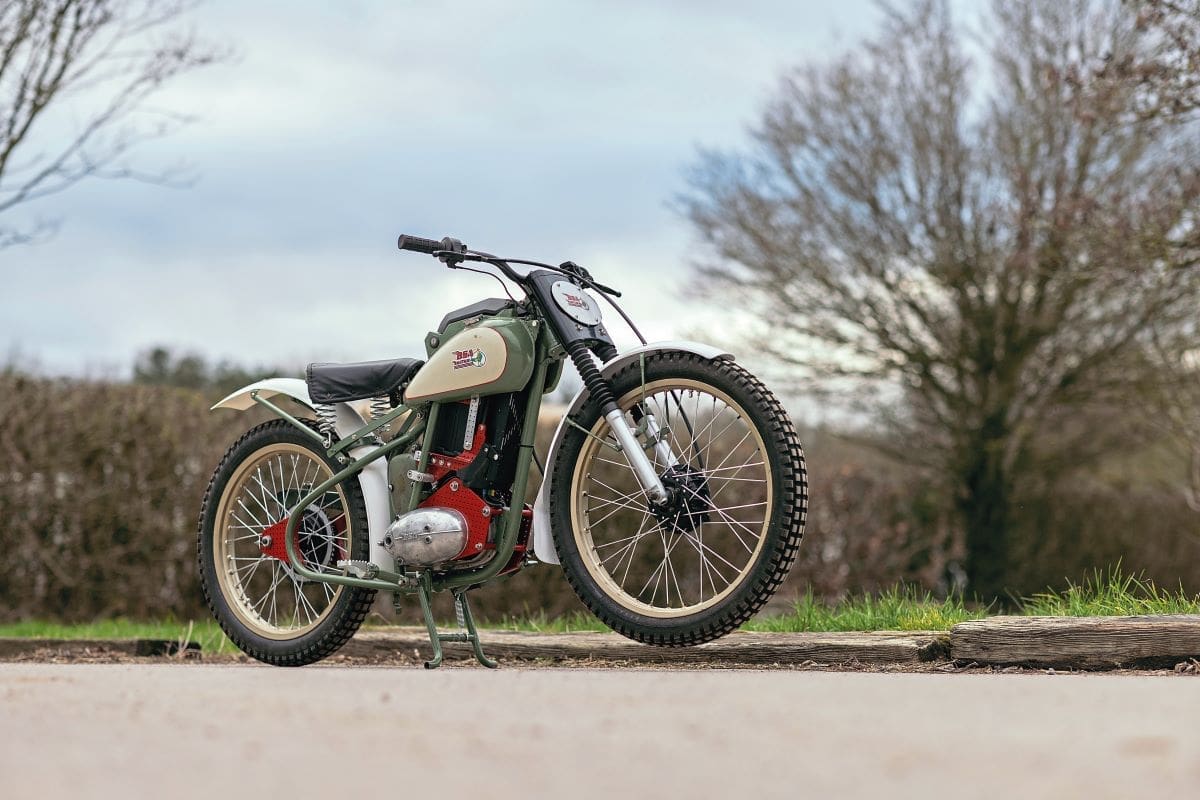
Words by Oli Hulme Photos by Gary Chapman
I heard it was called the Battery Hen, this remarkable little electric sort-of classic, the bike that won Most Technical Interest at the Bristol Classic Show. It’s a BSA Bantam, but not as we know it – it’s a BSA Bantam brought up to date.
The electric Bantam has a frame from a D1 Plunger Bantam from 1954, which at some point was converted into a schoolboy speedway bike, shortened and lightened. The bike’s creator, Bill Dutton, decided to stick the electric motor from a Sur Ron electric off-road motorcycle into the D1 frame.
Bill said: “I got the idea from an article I read about a luxury yachtsman who wanted a bike he could carry on board so he could get from ports to town, and he didn’t want to carry petrol and keep filling it up and draining it.”
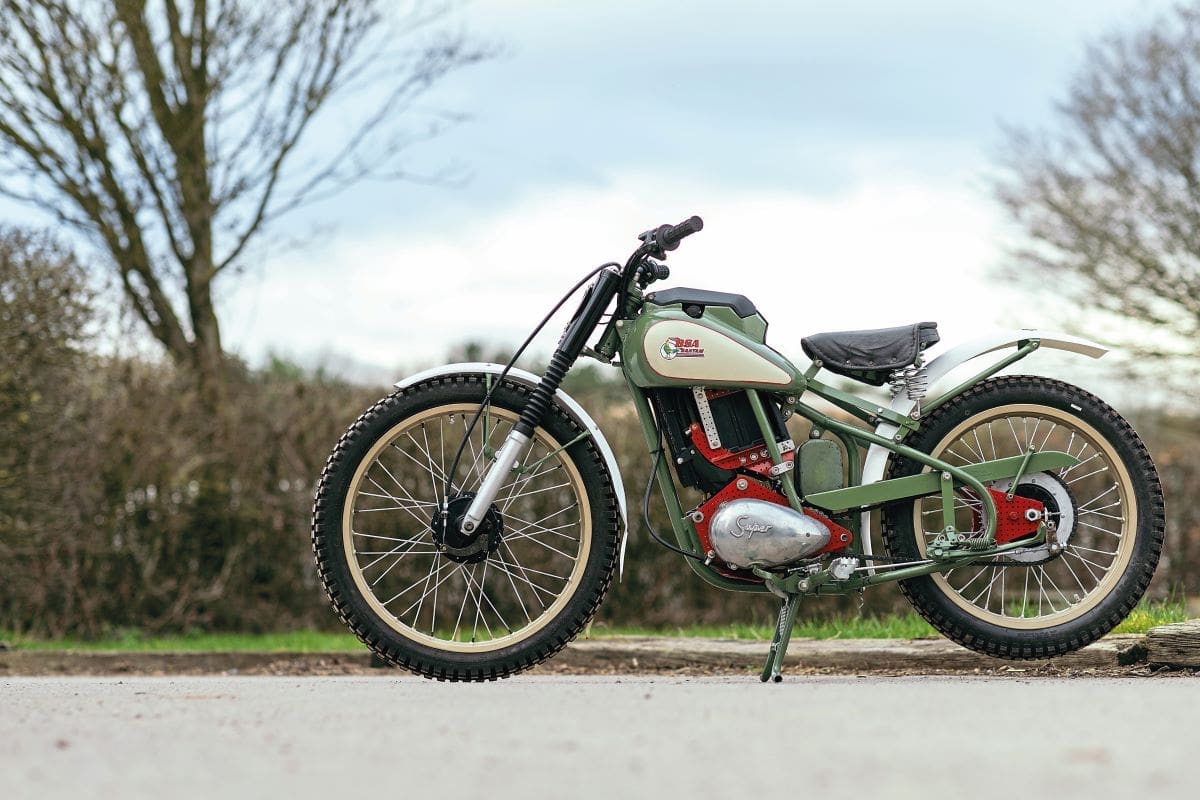
Restrictions are placed on petrol vehicles being carried on board yachts due the flammable nature of the fuel. The process of keeping within the rules is a lengthy and dirty one, resulting in the bike having to be stored empty of fuel, topped off if you want to ride it around, and the fuel tank having to be drained every time the motorcycle is loaded back on board, with the fuel then stored in a separate container in a secure location within the hull.
Bill continued: “He had wanted a classic-looking machine too, so designed the bike that ended up as the Veitis, which is a big V-twin lookalike and has a good range and top speed – but they do cost £40,000.”
The reason for using the Sur Ron electric motor was entirely pragmatic. Many people who buy the off-road electric bike quickly decide they want more power, and so swap the standard motor and controller for something bigger, resulting in lots of motors and controllers with next to no miles under their wirings becoming available on the second-hand market.
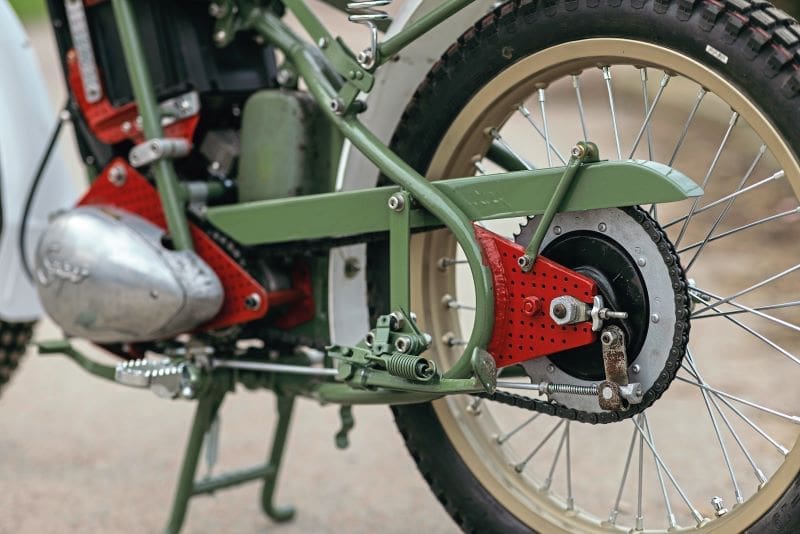

Starting at the front end, Bill took a set of forks from a Chinese copy of a Honda CG125. “They were very cheap at less that £100, brand new and a much better set of forks than you get with a stock D1. And at 27mm, they fit straight into a set of Bantam D7 yokes. I fitted taper roller headstock bearings, just because I couldn’t be bothered with mucking about with ball bearings.”
There was some small welding work needed to get the yokes to fit with the D1 steering lock. The front wheel is off a Honda Xl185 with a 21-inch rim, chosen partly because the 21-inch tyre was cheap. Because the frame from the D1 had been bent in its time on speedway’s cinder ovals and because space was needed to fit the battery, Bill cut the top tube out and used the rear subframe from another damaged Bantam frame to wrap around the battery location. This left a handy space for the battery, the cover where the petrol tank and top end of the Bantam’s engine would have once sat and the controller in front. This gives the battery-powered D1 the kind of centre of gravity you might expect from an off-road bike.
The powerful and compact Sur Ron motor was teased into a rescued set of damaged Bantam engine casings inside the frame cradle, then mounted between the outer casings using two 4mm mild steel plates, the design holding everything perfectly in line with the original Bantam’s rear axle and keeping the motor as low as possible, driving the rear wheel through a two-stage reduction gear from the primary side drive, under the D1 primary cover, through a shaft over to the left-hand side, to a gearbox sprocket and out to a Tiger Cub trials sprocket on the Bantam rear wheel. Bill said that if he was going to make the electric Bantam into a serious road bike, he would extend the main cable and fit an extra battery into a pannier at the rear, but as an off-road machine, he doesn’t need that kind of range.
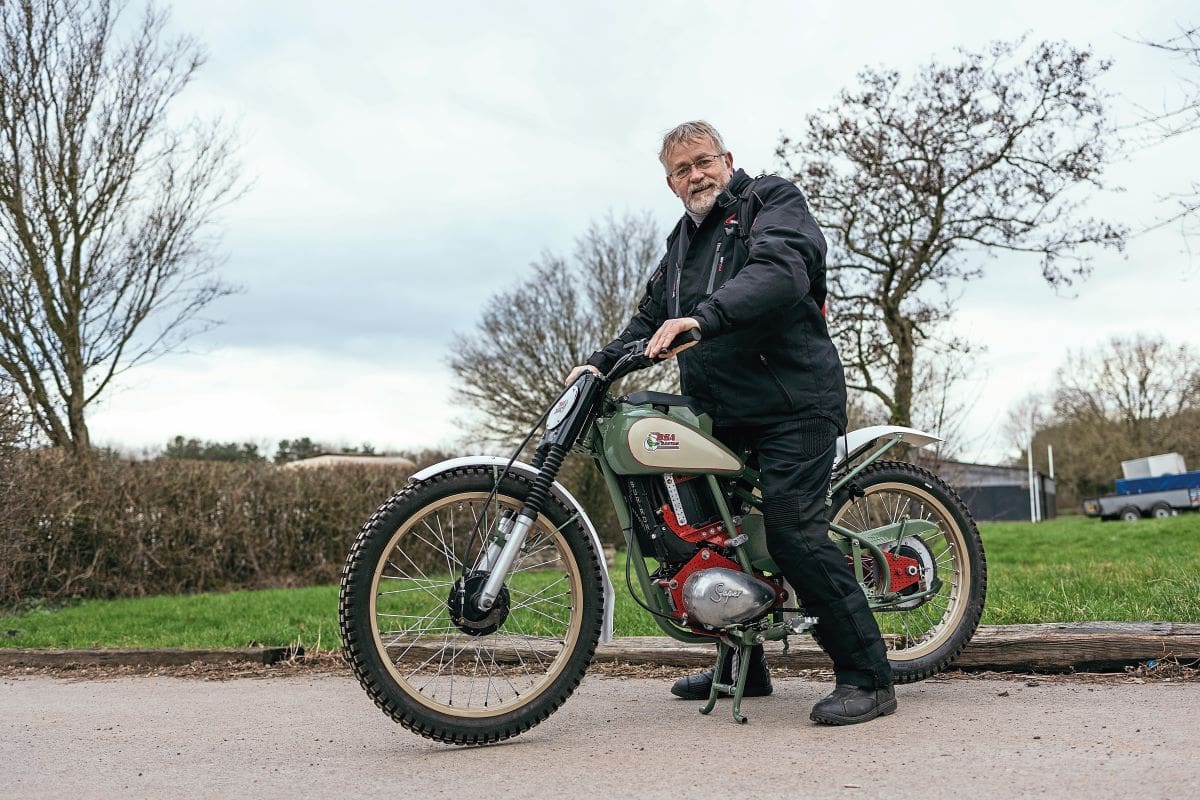
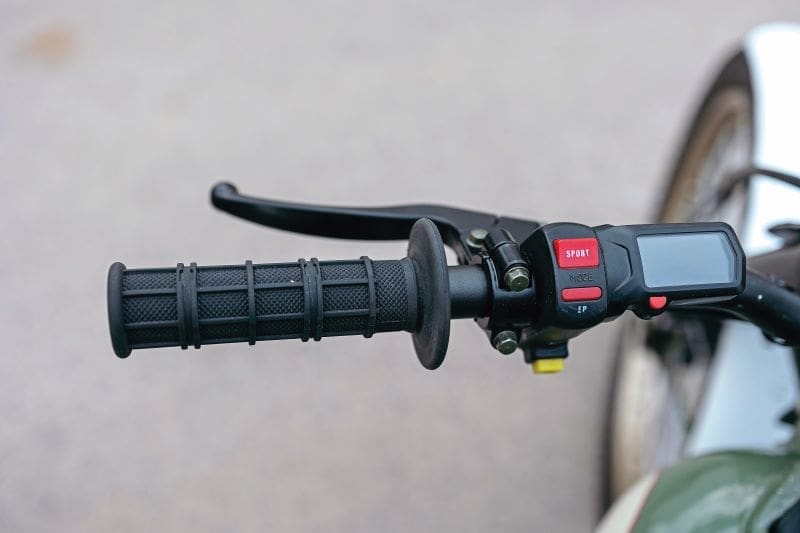
Off-road, the bike has a life of about two hours before needing a recharge, which can take about three hours to fill/charge up completely. The design is such that the battery could be swappable if he had another. It has a range of between 25 and 40 miles, depending on how you ride it, with a top speed of more than 40mph – and astonishing acceleration! You can run GPS off the standard Sur Ron wiring and electrical system, as well as lights. The electronic fly-by-wire twistgrip doesn’t operate like a traditional carburettor and you must use it gently to stop the bike shooting off into the distance at half throttle. The battery voltage is 60v and a 10-amp charger is used to charge it up again.

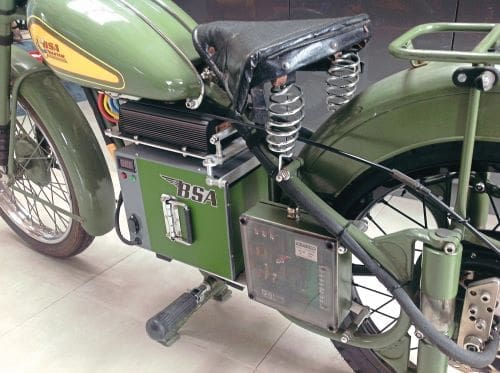
All the wiring connectors are standard automotive fittings available off the shelf online in the UK, and the only restriction on power it could produce is the size of the battery, controller and the gauge of the wires used to transfer the energy from battery to motor.
You could turn it into a road bike that would do a constant 50mph if you had a motor with a better stator to improve heat distribution.
The Sur Ron bike its motor comes from weighs about 45kg, while the Bantam comes in at about 80kg, but the advantage of this is that with the increased weight, it’s much more stable. It has a fully adjustable ‘regen’ (regeneration) setting, meaning that as you drop the throttle and slow down, the action of doing so puts power back into the battery. “You let off the power in sport, which is as standard, set to full regen and it recharges as it slows. If you want to bring it to standstill without the regen slowing it down, you flick the switch on the bars to economy and use the brakes.”
Electric off-roaders are gaining popularity – one popular conversion is to fit a four-speed Chinese motor and gearbox system into the Honda CRF 250 chassis. After decades of tutting from ramblers, horse riders and other countryside users, using an electric bike off-road is low-level and anonymous, and much less likely to upset people than the howl of a noisy two-stroke or thumping great single.
Bill’s bike, meanwhile, uses up an old, damaged frame from a redundant BSA, some old crankcases that had been previously butchered and a rusty fuel tank that couldn’t be saved. The cost came in at less than £4000. It’s not a real ‘classic’ anymore, but it never was really in the first place. It is a classic example of the great British tradition of people mucking about in sheds and creating remarkable stuff out of piles of scrap, just for the hell of it…
What supplies the power?
At its heart is the motor from a genuine electric motorcycle rather than a mountain bike with an electric hub motor bolted on. The Sur Ron LBX is described by those in the know as the two-wheel equivalent of the missing link – bridging the gap between electric bicycles and motorcycles. More lightweight enduro motorcycle than a souped-up push bike, the Sur Ron has a twist grip, no pedals, adjustable suspension and off-road tyres; in its road-legal set-up, the Sur Ron has mirrors, indictors headlights and a number plate, and is restricted to 28mph so it can be registered as a moped – but you can get it derestricted and made faster on the road if you have bike licence. The makers say that a fully derestricted Sur Ron can do 47mph for 24 miles. The power output on the restricted version is 4bhp. Or a bit less than a D1 Bantam, and derestricted it is 8bhp, about the same as a D7. Who are the people most interested in the Sur Ron? The world’s military…
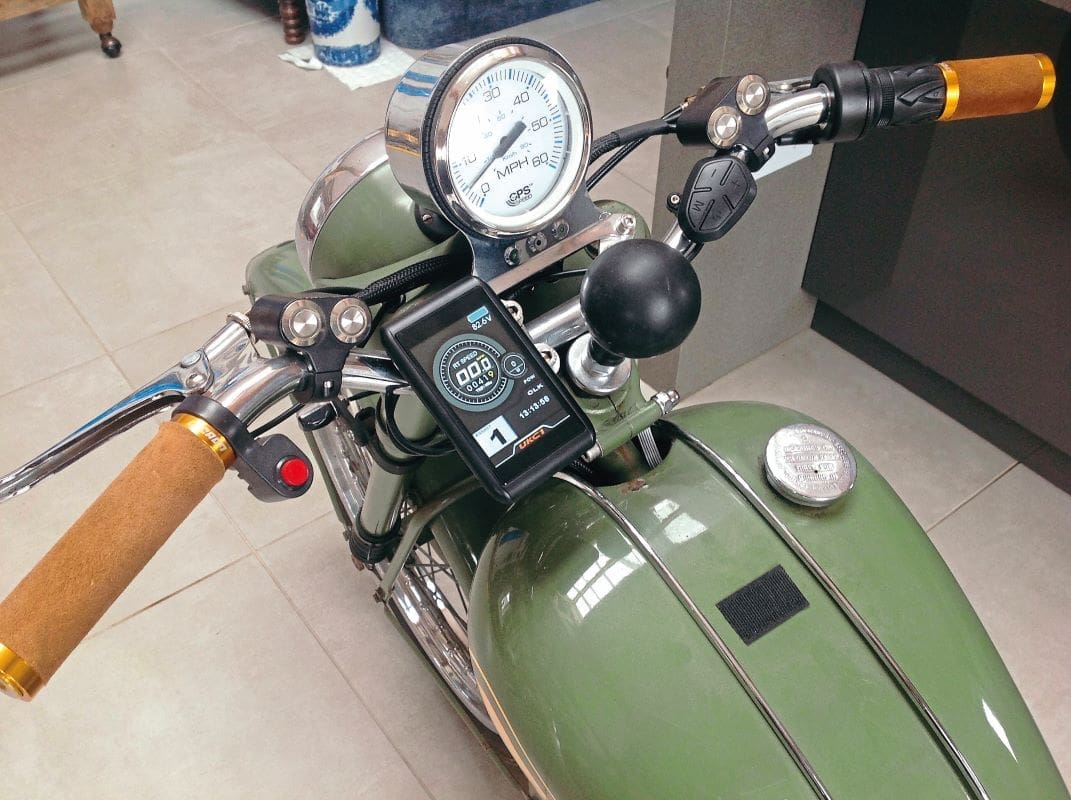
Gordon’s Electric D1
You wait ages for an electric Bantam and then two come along at once. Gordon Rennie, of Gourdon, Scotland, has built one, and his is fully road legal.
Gordon said: “I’ve always been interested in electric vehicles and decided to build my own as a lockdown project. I bought the D1 with the intention of converting it – it was quite oily when I got it!”
The power is delivered by an electric wheel hub motor (you might have seen something similar in the commercially available Maeving two-wheeler). Gordon sourced it from China, and it has a power of 5kw – which Gordon estimates is about the same as a 175cc petrol engine.
“It’s the same size as the original wheel, but the factory said it can build anything you want in any size – and it came with the tyre on!”
The same supplier provided the all-important controller that regulates power and acceleration, and it also has a regen function. The 72v battery, in the frame’s cradle, is a large unit and was the most expensive part of the build. It gives the D1 a range of between 40 and 50 miles.
The main bit of engineering involved was fitting some strong torque arms to the hub drive motor: “All the power goes through the rear axle, which has a tendency to spin if it’s not securely mounted, so I fitted plates to the plunger brackets to stop it moving around. The torque is amazing. I reckon you could wheelie it with a bit too much throttle – I’ve definitely felt the front end starting to lift.”
With the battery and motor in place, Gordon modestly said: “There wasn’t a lot else to do.” The bike’s lights and components were rewired to use LED bulbs and there’s a very neat set of discrete but bright LED indicators. “It goes really well,” he added, “and it gets a fair crowd of people round it when I stop anywhere.”
Fancy owning an electric Bantam of your very own? Gordon’s is for sale on the Car and Classic website – just search for BSA in Scotland.
Electric motorcycles – a (very) brief history
Electric cars, buses and lorries briefly challenged the internal combustion engine at the end of the 19th century, as they were cleaner and more reliable than their dinosaur juice-powered rivals, despite having limited range and huge lead/acid batteries.
As the IC engine became more efficient and networks of filling stations arrived, the electric car dropped out of favour.
There were a few efforts to build electric motorcycles, despite the problems that arose from using huge batteries on two-wheeled velocipedes. In 1897, one Hosea W Libbey, from Boston, Massachusetts, patented an electric bicycle with a centrally mounted electric motor driving the rear wheel by using two drive shafts, one on each side like a steam locomotive, rather than a belt or chain.
There was also an attempt to create a bicycle with two generators charging a battery that could assist pedalling in a primitive regen system and a number of friction drive bolt-on devices were created, but the internal combustion engine was simply more practical.
In the UK, Humber built an electrically powered tandem in 1898, which had a useful life on cycle race tracks, where it was used for pacing.
In the 1960s, the Winn Bike was created in the UK – a tiny folding scooter that followed the same principles as Honda’s much later Motocompo folding bike. The Winn had a folding seat and handlebars, and was designed to be kept in the boot of a car so people could drive into the outskirts of cities, get out their Winn and wobble into work. It had a short range and was powered by a large car battery, connected to an electric motor, and this drove the rear wheel with a rubber belt. A few were made and registered for the road.
Apart from the short-lived Sinclair C5, that was it until the recent development of lighter batteries and powerful motors – and you can bet there will be many more electric motorcycles turning up near you soon, possibly in your own shed…



